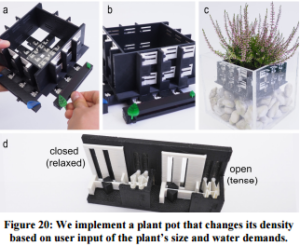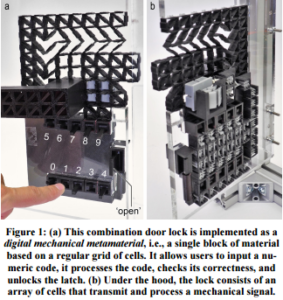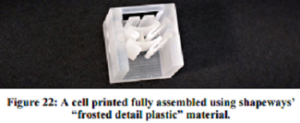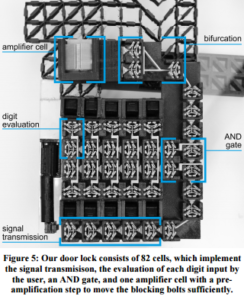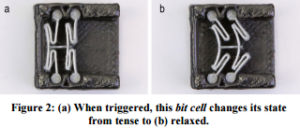 Just a few months ago, we told you about a really interesting metamaterials project developed by a team of researchers at Germany’s Hasso-Plattner Institute (HPI). The researchers created a 3D printed working door handle using metamaterials, without a single moving part inside and 3D printed in one piece. The handle itself is actually more 4D, because the metamaterials adapt to its movement when the door is opened or closed. The HPI researchers outlined the project in a research paper, and explained that they chose a door handle to highlight how common household objects can be improved by 3D printing.
Just a few months ago, we told you about a really interesting metamaterials project developed by a team of researchers at Germany’s Hasso-Plattner Institute (HPI). The researchers created a 3D printed working door handle using metamaterials, without a single moving part inside and 3D printed in one piece. The handle itself is actually more 4D, because the metamaterials adapt to its movement when the door is opened or closed. The HPI researchers outlined the project in a research paper, and explained that they chose a door handle to highlight how common household objects can be improved by 3D printing.
 The 3D printed door handle was decidedly complex: the structure was a grid of cells, able to collapse once pressure was applied in pre-determined directions. The latch, part of a rigid system, then retracted, opening the door. Padded structure areas actually received the force, and then increased stability by connecting the door and the latch. The whole object was fabricated without any moving parts that needed to be assembled post-print job. The HPI researchers even developed their own 3D editor, which lets users make functional objects out of metamaterials on their own.
The 3D printed door handle was decidedly complex: the structure was a grid of cells, able to collapse once pressure was applied in pre-determined directions. The latch, part of a rigid system, then retracted, opening the door. Padded structure areas actually received the force, and then increased stability by connecting the door and the latch. The whole object was fabricated without any moving parts that needed to be assembled post-print job. The HPI researchers even developed their own 3D editor, which lets users make functional objects out of metamaterials on their own.
Metamaterials can morph according to their environment, and make up a new class of finely-engineered surfaces capable of performing tasks that defy nature, like shaping the acoustic field with 3D printed metamaterial bricks, manipulating light to create an invisibility cloak, and 3D printing holograms. Building on their 3D printed door latch and metamaterials research, the team is back again, and this time created a 3D printed, PIN-protected door lock. This was obviously a little more complicated than their original latch, but their work has shown that it’s possible to secure a door without circuits and electronics.
Several members of the 3D printed door handle team came back for this project, and PhD students Alexandra Ion, Ludwig Hall, and Robert Kovacs, together with Dr. Patrick Baudisch, the chair of HPI’s Human Computer Interaction Lab, co-authored a paper entitled “Digital Mechanical Metamaterials” on their 3D printed, PIN-protected door lock. Researchers with the Human Computer Interaction Lab believe that mechanical engineering and computer science will soon unite, allowing computing to reach its next phase of merging into matter. The objective of the lab’s work is to unify “the virtual world of the computer with the physical world of the user into a single space.”
According to the abstract, “In this paper, we explore how to embody mechanical computation into 3D printed objects, i.e., without electronic sensors, actuators, or controllers used for this purpose. A key benefit of our approach is that the resulting objects can be 3D printed in one piece and thus do not require assembly. We are building on 3D printed cell structures, also known as metamaterials. We introduce a new type of cell that propagates a digital mechanical signal using an embedded bistable spring. When triggered, the embedded spring discharges and the resulting impulse triggers one or more neighboring cells, resulting in signal propagation. We extend this basic mechanism to implement simple logic functions. We demonstrate interactive objects based on this concept, such as a combination lock. We present a custom editor that allows users to model 3D objects, route signals, simulate signal flow, and synthesize cell patterns.”
 The key to the functionality of the 3D printed lock is its series of bit cells, which contain plastic bistable springs. Metal coiled springs always want to expand, but these plastic springs stay resting in one of two different positions. The 3D printed door lock is made up of a total of 82 cells, which have a number of different tasks. Specific springs are triggered inside the lock when a person enters the correct sequence of buttons on the outside, resulting in a large chain reaction that allows the door to be unlocked with the correct PIN. The bit cells are 3D printed for the HPI research team at Shapeways.
The key to the functionality of the 3D printed lock is its series of bit cells, which contain plastic bistable springs. Metal coiled springs always want to expand, but these plastic springs stay resting in one of two different positions. The 3D printed door lock is made up of a total of 82 cells, which have a number of different tasks. Specific springs are triggered inside the lock when a person enters the correct sequence of buttons on the outside, resulting in a large chain reaction that allows the door to be unlocked with the correct PIN. The bit cells are 3D printed for the HPI research team at Shapeways.
The entire mechanism is really extraordinary, but going back to HPI’s original point that 3D printing can improve upon common household objects, I wonder if it’s true in this case. While this 3D printed, PIN-protected door lock may look pretty intimidating, we shouldn’t forget that it is, in fact, made of plastic. But this metamaterials research does continue to demonstrate the wondrous potential of 3D printing technology in the manufacturing sector: maybe someday, whole machines could be created without any assembly after the print job is done. Discuss in the Metamaterials forum at 3DPB.com.
Subscribe to Our Email Newsletter
Stay up-to-date on all the latest news from the 3D printing industry and receive information and offers from third party vendors.
You May Also Like
Precision at the Microscale: UK Researchers Advance Medical Devices with BMF’s 3D Printing Tech
University of Nottingham researchers are using Boston Micro Fabrication‘s (BMF) 3D printing technology to develop medical devices that improve compatibility with human tissue. Funded by a UK grant, this project...
3D Printing Webinar and Event Roundup: April 21, 2024
It’s another busy week of webinars and events, starting with Hannover Messe in Germany and continuing with Metalcasting Congress, Chinaplas, TechBlick’s Innovation Festival, and more. Stratasys continues its advanced training...
3D Printing Webinar and Event Roundup: March 17, 2024
It’s another busy week of webinars and events, including SALMED 2024 and AM Forum in Berlin. Stratasys continues its in-person training and is offering two webinars, ASTM is holding a...
3D Printed Micro Antenna is 15% Smaller and 6X Lighter
Horizon Microtechnologies has achieved success in creating a high-frequency D-Band horn antenna through micro 3D printing. However, this achievement did not rely solely on 3D printing; it involved a combination...


